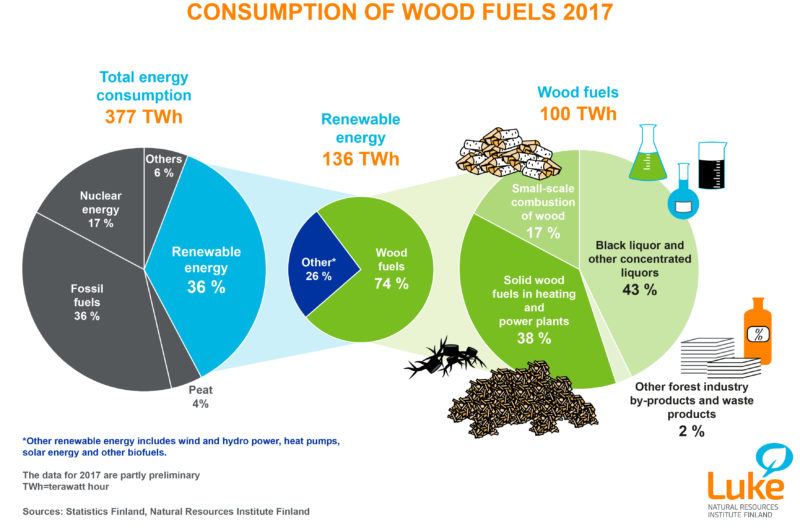The use of wood in energy generation reached a new record in 2017
More wood fuels were consumed in Finland in 2017 than ever before. They represented the most important energy source in Finland, covering 27% of the total energy consumption.

According to the statistics of the Natural Resources Institute Finland (Luke), a new record was reached in the consumption of solid wood fuels at power and heating plants. This was based on an increase in burning forest industry by-products and wood residues. Instead, the consumption of forest chips decreased. The consumption of wood fuels continues to grow. According to preliminary data of Statistics Finland, the total consumption of wood fuels exceeded the limit of 100 terawatt-hours for the first time in 2017.
“Wood fuels were also the most important energy source in Finland, as they accounted for 27% of the total energy consumption”, says Esa Ylitalo, Senior Statistician at Luke.
Of the total consumption, solid wood fuels used at power and heating plants accounted for 38 terawatt-hours, the burning of black liquor made up 43 terawatt-hours, the small-scale combustion of wood comprised 17 terawatt-hours and other wood fuels covered 2 terawatt-hours.
Record-high consumption of solid wood fuels
According to Luke’s statistics, heating and power plants consumed nearly 20 million solid cubic metres (38 terawatt-hours) of solid wood fuels in 2017. This is the highest figure ever recorded in statistics and increased by 2% from the previous year.
According to Ylitalo, this growth in the consumption of wood fuels was based on an increase in burning forest industry by-products and wood residues. As a result of the positive trend in the forest industries, the consumption of roundwood is higher than before, meaning that more by-products are also available.
Bark is the most significant by-product
In 2017, the volume of various by-products burned was 6% higher than in the previous year, totalling 11.7 million cubic metres. This is also a new record. The main by-product used in burning was bark, accounting for nearly two-thirds, or 7.7 million cubic metres, of all by-products, and showing an increase of 4% from the year before. The consumption of sawdusts was 2.8 million cubic metres (+12%) and that of industrial chips was 1.2 million cubic metres (+5%).
Forest chips looking for their way
The use of forest chips, defined as the driver of the increasing use of renewable energy in Finland’s previous Climate and Energy Strategy, has remained practically unchanged in Finland in recent years. We are clearly falling behind the goals set for their use. In 2017, the consumption of forest chips decreased by 3% from the previous year to 7.2 million cubic metres. When measured by volume, forest chips lost their leading position held since 2010, becoming, for the first time, the second most significant solid wood fuel after bark.
The use of forest chips decreased by 7% to 4.6 million cubic metres in combined heat and power production, while it increased by 4% to 2.6 million cubic metres in the generation of heat.
“Combined with the roughly one million cubic metres burned in small-scale housing, the total consumption of forest chips was 7.8 million cubic metres, showing a decrease of 3% from the previous year”, Ylitalo says.





